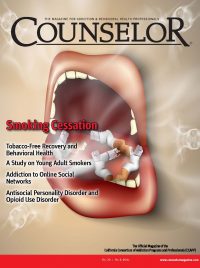Share
Quitting smoking is hard. That is why smoking cessation rates among US adult smokers have remained low over the years: in 2017 only 7 percent of smokers succeeded in quitting smoking (Babb, Malarcher, Schauer, Asman, & Jamal, 2017). Additionally, success in quitting smoking varies by race/ethnicity—only 5 percent of non-Hispanic black smokers succeeded in quitting smoking over a twelve-month period, while 7 percent of non-Hispanic white and 8 percent of Hispanic smokers succeeded in quitting smoking (Babb et al., 2017). Moreover, smokers with less education are less likely than those with more education to succeed in quitting smoking, partly because they were less likely to make quit attempts (Zhuang, Gamst, Cummins, Wolfson, & Zhu, 2015). Using evidence-based cessation treatments can make quitting smoking easier. However, only 31 percent of US adult smokers used cessation counseling and/or medication when trying to quit smoking (Babb et al., 2017).
While quitting smoking offers health benefits at any age, quitting during young adulthood is associated with significant improved health outcomes later in life compared to quitting later in life (Doll, Peto, Boreham, & Sutherland, 2004; Taylor, Hasselblad, Henley, Thun, & Sloan, 2002). Yet, young adult smokers are less likely than older smokers to be interested in quitting smoking (Babb et al., 2017). Likewise, young adults were less likely to report using evidence-based cessation treatments (e.g., counseling or medications). Given the high burden of smoking in racial-/ethnic-minority and lower-socioeconomic-status populations and the benefit of quitting smoking during young adulthood, promoting evidence-based smoking cessation treatment use, especially among non-college-educated young adult smokers from racial-/ethnic-minority populations is important.
Health behavioral theories point out that perceptions and beliefs about a health behavior drive the intention to engage in said behavior, and that ultimately this intention translates into actually engaging in the health behavior (Ferrer & Klein, 2015). Specific to smoking cessation, smokers who displayed negative perceptions—for example, they expressed concerns about potential side effects and believed treatments to be ineffective—had low intention to use and poor adherence to pharmacotherapies compared to those who did not display these negative perceptions (Morphett, Partridge, Gartner, Carter, & Hall, 2015; Fucito, Toll, Salovey, & O’Malley, 2009).
Previous studies have suggested that perceptions about smoking cessation treatments varied by race/ethnicity. Solomon and colleagues (2009) found that, when examining perceptions related to telephone-based smoking cessation counseling, and when compared to black adult smokers, white adult smokers were more concerned about privacy and less confident about the efficacy of telephone counseling. Burns, Deaton, and Levinson (2011) found that Latino adult smokers reported low intention to use telephone-based smoking cessation counseling because they did not see the need for assistance with smoking cessation. However, little is known about young adult smokers’ perceptions and beliefs of various smoking cessation methods approved by the US Food and Drug Administration (FDA), especially among less educated, racial-/ethnic-minority, young adult smokers.
Focus Group Interviewing
To better understand how non-college-educated young adult smokers with diverse racial/ethnic backgrounds perceive various ways of quitting smoking, we conducted a set of twelve focus group interviews to explore awareness, beliefs, past usage, and future intentions of using various smoking cessation treatments. These treatments included FDA-approved methods—namely nicotine replacement therapy (NRT), prescription medications, and behavioral programs/counseling—as well as alternative cessation methods volunteered by the participants.
We invited individuals who met the following criteria to participate in the interviews:
- Between eighteen to twenty-nine years old
- Residing in the Washington, DC metropolitan area (including Washington, DC; Maryland; and Virginia)
- Self-identified as white, black, or Hispanic
- Attained less than a four-year college education
- Earned less than the median household income of the Washington, DC metropolitan area (i.e., $90,000)
- Reported currently smoking
Before taking part in the interview, young adult smokers completed an anonymous online survey that collected information on demographics, tobacco use behaviors, past cessation treatment use, and tobacco-related attitudes and beliefs. At the interviews, young adult smokers were assigned into groups based on their educational attainment (high school or less versus some college without obtaining a bachelor’s degree) and race/ethnicity (Hispanic versus black versus white). We held two focus group interviews per each combination of educational attainment and race/ethnicity, resulting in a total of twelve focus group interviews.
Using a discussion guide developed by our research team, the focus group moderator began the discussions by asking participants if they were aware of different cessation treatments, including behavioral counseling programs (e.g., phone coaching, one-on-one counseling, and group counseling with a health professional), prescription medications (e.g., Wellbutrin, Zyban, Bupropion, Chantix, or Varenicline), and over-the-counter NRTs (e.g., nicotine patches, gum, lozenges, nasal sprays, or nicotine inhalers). The moderator then explored where these young adult smokers learned about each treatment, the perceived benefits and disadvantages of each treatment, past experiences with each treatment, and interests in using each treatment in the future. Participants were also asked to suggest other smoking cessation methods and discussed their perceived benefits and disadvantages as well as their interest to use these methods in the future.
Audio recordings of the focus group discussions were transcribed verbatim. We developed a coding scheme through an iterative process of reviewing the transcripts, revising the coding scheme, applying the coding scheme, and reviewing the codes until we reached a satisfactory level of agreement between coders. We then applied the coding scheme to all transcripts using an online, qualitative, data-analysis platform called Dedoose. Representative quotes were selected from the transcripts for further analysis and comparison across educational attainments and races/ethnicities.
The Young Adult Smokers We Interviewed
We had a total of seventy-five young adult smokers who participated in the focus group interviews. Based on their responses to the online survey, 63 percent were men and 48 percent had a high school education or less, while 52 percent had some college education without a four-year degree. Moreover, 29 percent of participants reported low income of USD $10,000–$24,999, 47 percent reported low income of USD $25,000–$49,999, and 24 percent reported lower than median income USD $50,000–$89,999. In addition to smoking cigarettes, 48 percent reported using e-cigarettes, 47 percent reported using cigars, 37 percent reported using hookah, 23 percent reported using roll-your-own cigarettes, and 3 percent reported using smokeless tobacco. Many have tried to quit smoking (65 percent), 12 percent have used NRT, 6 percent have used prescription medications, and 10 percent have used behavioral counseling programs when trying to quit. Other cessation methods were also mentioned by these young adult smokers: 78 percent reported quitting cold turkey and 41 percent reported using e-cigarettes to quit smoking.
What They Think about Nicotine Replacement Therapy (NRT)
Young adult smokers in the study were aware of NRT. However, most of them had negative perceptions of it. Some participants did not like the taste of nicotine gums, saying they tasted “disgusting” and “awful.” Some said NRT was expensive, costing them as much as or more than cigarettes. Some participants said these high prices stopped them from trying and continuing with NRT. Many participants also thought NRT was not effective because it does not reduce “cravings” for cigarettes. Some participants reported they, their friends, or their families had to simultaneously use NRT and cigarettes to satisfy their cravings for nicotine when quitting smoking.
These perceptions varied somewhat by educational attainment. Participants with some college education were more likely than those with high school education or less to report using NRT and discussed its benefits. These perceived benefits included “convenience,” because smokers could “wear [the patches] on the go”; and not being as “intrusive” as smoking, because they could use them in public places where smoking is prohibited. Another benefit was the stimulation from nicotine (especially from nicotine gums), which helped them feel more “alert and awake” and gave them a “light buzz.”
What They Think about Prescription Medications for Smoking Cessation
The moderators read aloud a list of prescription medications for smoking cessation. Many young adult smokers in the study recognized Chantix, and a small number of them recognized Wellbutrin. A few of them used Chantix before, and a couple of them had used Wellbutrin. A few others had heard about their families’ and/or friends’ experiences with Chantix.
Those who used Chantix and Wellbutrin reported first-hand experiences of their side effects. For example, one said, “The dreams [after using Chantix] were insane . . . I stopped taking them because of the dreams.” Another participant reported a potential drug interaction with Wellbutrin: “Taking the Wellbutrin combined with the other [medication], it was a bad effect. So, I just didn’t take that [Wellbutrin].” Participants who used Chantix and Wellbutrin also reported that these medications were not effective for them (e.g., “The Wellbutrin, I don’t think it did anything for me. And plus it just, it tripped me out because it was, you know, all the side effects”).
Even those who have not used these medications reported hearing anecdotes of side effects from family members and friends related to these medications. They included personality changes (e.g., “He didn’t seem like his usual self for a pretty long time after [using Chantix]”), as well as having “nightmares, depression,” and suicidal thoughts (e.g., “Somebody tried it and it made them want to kill themselves.”) Consequently, many participants expressed reservations about using medications for smoking cessation in general (e.g., “I wouldn’t want to take—put other toxins or drugs in my body—to [quit smoking], especially that have side effects . . . it scares you”).
These perceptions again varied by educational attainment. Participants with some college education tended to hear anecdotes about prescription medications from a third party (i.e., friends or family). Many of these anecdotes were successful stories about prescription medications that helped people quit smoking. In contrast, participants with high school educations or less primarily heard of prescription medications from television commercials. Moreover, most of them did not report hearing success stories with these medications from their social networks. A few participants with some college education expressed interest in using Chantix, only for a short period of time, or when these medications were paired with other treatments (e.g., “Addiction is like an imbalance in your mind, in your body . . . [medications to treat addition] would need to be paired with something else, almost like an antidepressant”). However, participants with high school educations or less did not report interest in using prescription medications to quit smoking, in part due to their financial cost (e.g., “I’ve never tried it because I can’t afford it”).

What They Think about Behavioral Counseling for Smoking Cessation
Few young adult smokers were aware of any behavioral counseling programs available for smoking cessation. Two participants named the “1-800 quitline” (which is actually 1-800-QUIT-NOW) and reported seeing commercials about the service on television. One participant reported using the service: “I called before, and they sent free patches, and gum, and stuff like that.” A few participants heard of smoking cessation counseling groups (e.g., “Cigarette Anonymous [referring to Smokers Anonymous],” “In my building, they had something every week. Somebody come[s] in and it’s a cessation program”), though none had actually tried these groups.
Many participants expressed they did not know much about the contents and processes of behavioral counseling programs. One stated, “I just don’t know what I would expect from [phone counseling].” Because of this, the moderator explained the contents and processes of these programs to the participants. Interestingly, after the explanation, many participants said they were interested in these programs and thought they could be helpful for smoking cessation. One participant welcomed the emotional support that could be provided by these programs, saying, “Because most of my reasons for smoking is I need someone to talk to, and I don’t have someone to talk to.” Another participant believed one-on-one counseling would be more personal, expressing that it “can . . . tailor it to why you smoke, and what can help you stop versus just, you have the biological part, but everything else is in your head . . . Maybe somebody could help you figure it out.” Another participant indicated that “[behavioral programs] would be my first route [to] get counseling on how to deal with the cravings” before using NRT or prescription medications.
Not all young adult smokers thought behavioral counseling would be helpful for them for the following reasons: having certain personality types (e.g., “I’m extremely hard headed”), not knowing people who used these programs, and perceiving these programs to be time consuming (e.g., “I don’t have time to go out and just sit for an hour and talk to somebody or sit in a group”) and only for those addicted to cigarettes.
Smartphone applications for smoking cessation were brought up during the interviews as well. A few participants used them or heard of them from their families. One participant said some applications showed the immediate health benefits of quitting smoking (e.g., improved heart rate and blood pressure), which were “huge motivator[s] to quit smoking.” However, another participant believed that these applications “would make it worse,” because “I’m more of an out-of-sight, out-of-mind kind of person” (i.e., they do not crave cigarettes when they are not exposed to triggers). These participants thought the applications would remind them of smoking.
Telephone counseling and group counseling were mentioned by participants of all educational attainments in the study. Meanwhile, smartphone applications were only mentioned by those with some college education. More participants with some college education were interested in using behavioral counseling programs than those with high school educations or less, even after the explanation provided by the moderator.
Cold Turkey: The Preferred Approach to Smoking Cessation
Cold turkey—that is, abruptly stopping smoking altogether—was frequently mentioned by many young adult smokers as their preferred way to quit smoking. Many participants believed that quitting smoking was a matter of mental determination. One stated, “You have to put it in your mind and then you set that goal . . . you got to be willing to stop on your own.” Another also claimed, “It’s a mind—it’s a mental decision [to quit smoking]” and NRT and prescription medications were “just another ploy to keep you in [the addiction].” These sentiments were echoed by other participants. A couple of participants said they were successful in quitting smoking for a short period of time by going cold turkey. Several recalled their families and/or friends quit smoking cold turkey (e.g., “Only people I know [that] successfully quit smoking cigarettes is cold turkey,” “[my best friend] eventually [quit smoking] cold turkey”).
Several participants acknowledged that quitting cold turkey was difficult (e.g., “You gotta tell yourself ‘no’, but like it’s hard to tell yourself ‘no’ sometimes,” “You’re probably not going to stop cold turkey because it’s hard for a smoker to stop cold turkey”). Some participants tried to gradually wean themselves off cigarettes instead. Despite the fact that all participants failed to sustain abstinence from smoking by going cold turkey, they still indicated they would go cold turkey in the future (e.g., “I would just say, you’ve got to go cold turkey. If you would say to yourself that you don’t want to smoke, have a legitimate reason that you want to stop smoking for, and stick to it”) instead of utilizing other cessation treatments (e.g., “You know why everybody don’t want to go and [use different cessation treatments]? You just got to quit. As you know, you got to stick to it and quit”).
Using E-Cigarettes to Quit Smoking without Success
Young adult smokers in the study commonly mentioned using e-cigarettes as a smoking cessation method. It was used mostly by white participants and those with some college education. Even those who never used e-cigarettes reported hearing about family and/or friends using e-cigarettes to quit smoking. Some found e-cigarettes beneficial because they mimicked the action of smoking and could satisfy nicotine cravings. Several others described how e-cigarettes were convenient to use because they are noncombustible and they could use them in bathrooms, cars, or general work areas without worrying about “[setting] off fireworks” (i.e., a smoke alarm) or bothering other people with the smell of cigarettes. Several participants said some brands of e-cigarettes were “tiny” enough “to fit in [their] pocket” so they were able to take them anywhere. Some participants also expressed that e-cigarettes had a “good flavor” compared to cigarettes. However, those who used e-cigarettes reported that use did not result in long-term cessation (e.g., “It doesn’t take away the [nicotine] cravings or the actual craving of the cigarette. You’re just like, ‘I want a cigarette after this’,”). Several participants reported they ended up using e-cigarettes and cigarettes or increased nicotine addiction after using e-cigarettes (e.g., “I tried vaping, but then it made me smoke [cigarettes] more”).
Other Cessation Methods Used by Young Adult Smokers
Hypnosis was mentioned as an alternative cessation treatment. Some participants thought that hypnosis was “appealing” and some heard success stories about hypnosis (e.g., “My aunt had hypnosis, and it worked really well for her”). Many participants with some college education expressed interest in hypnosis. In contrast, some rejected hypnosis, stating they did not “want people in [their] personal business.” White participants also suggested several other smoking cessation methods, such as substitutions with marijuana. Several white participants said they preferred marijuana over cigarettes and using marijuana to reduce cigarette consumption (e.g., “I don’t know if it’s just the act of smoking or what, but when I’m smoking a ton of weed, I don’t really care about cigarettes”). Hispanic participants also mentioned substituting cigarettes with marijuana to quit smoking. One participant also reported blunt use: “I do with the cigarillos the blunt that has a little tobacco leaf on it.” Several participants with some college education also reported replacing cigarette smoking with other oral fixations (e.g., food) or exercise.
Implications for Smoking Cessation Treatment in This Population
We found that, in a group of non-college-educated white, black, and Hispanic young adult smokers, perception and beliefs about smoking cessation treatments appear to be mostly negative, ranging from distasteful, expensive, ineffective, to the side effects being too severe. Young adult smokers in our study also believed quitting smoking was a personal responsibility, cold turkey was the preferred way to quit smoking, and using NRT and prescription medications for smoking cessation showed mental weakness and lack of determination to quit smoking. Given the previously reported association between negative perceptions of pharmacotherapy and low prevalence of pharmacotherapy use in general adult smokers (Ryan, Garrett-Mayer, Alberg, Cartmell, & Carpenter, 2011), our observations may explain the low prevalence of using FDA-approved smoking cessation treatments among young adult smokers, especially among those with lower educational attainment (Curry, Sporer, Pugach, Campbell, & Emery, 2007).
It is noteworthy that many non-college-educated young adult smokers in our study were unaware of behavioral counseling programs for smoking cessation. Moreover, those who were aware of these programs were unable to describe the contents and processes of the programs, and how the products can specifically aid smoking cessation. This seems counterintuitive since smoking cessation media campaigns often include information on how to access behavioral counseling programs. However, these campaign messages do not explain what smokers should expect when calling the phone number (e.g., 1-800-QUIT-NOW). Consequently, non-college-educated young adult smokers in our study remained unclear about how calling the phone number could be helpful in quitting smoking. Since some participants expressed interest in using behavioral counseling programs after they had a better understanding of these programs, explaining the contents and processes of these programs, even to non-college-educated young adult smokers who may not be initially interested in using the programs, may help them become interested in behavioral counseling.
It may also be important to fully discuss the benefits and perceived disadvantages of FDA-approved smoking cessation treatments with non-college-educated young adult smokers with diverse racial/ethnic backgrounds. This is because, as we observed, discussions related to prior use of FDA-approved smoking cessation treatments were more prevalent in white young adult smokers compared to black and Hispanic young adult smokers, and participants with some college education tended to be more knowledgeable about FDA-approved cessation methods than those with high school educations or less. This could be due to the higher prevalence of pharmacotherapy use among white and more educated young adult smokers in general (Curry et al., 2007). This also implies that racial/ethnic minorities and less-educated young adult smokers have fewer individuals in their social networks who can share their experiences with these treatments. Likewise, among those who do share, they often only disclosed bad experiences. Addressing specific negative perceptions and beliefs associated with each treatment may increase uptake of FDA-approved cessation treatments in these populations.
Young adult smokers in our study have tried other ways to quit smoking. E-cigarettes were commonly reported as their smoking cessation tools of choice. However, participants who used
e-cigarettes did not successfully quit smoking, and many ended up using both products. Previous studies have shown that e-cigarette use in general is not associated with smoking cessation (Kalkhoran & Glantz, 2016). However, additional research suggests that daily
e-cigarette use is associated with smoking cessation (Coleman et al., 2019), though there is a lack of scientific evidence to suggest e-cigarettes be used specifically as a smoking cessation treatment.
When helping non-college-educated young adult smokers from diverse racial/ethnic backgrounds, we need to be mindful that they may use other substances to quit smoking. Marijuana was reportedly used as a substitute to cigarettes. Previous studies found that individuals who smoked both marijuana and tobacco were less likely than those who used only tobacco to quit smoking (Peters, Budney, & Carroll, 2012). Therefore, non-college-educated young adults who dual-use cigarettes and marijuana may need additional support to quit smoking. Unfortunately, how to effectively assist these dual users to quit tobacco remains unclear (Agrawal, Budney, & Lynskey, 2012).
Limitations
Our findings need to be interpreted with the following limitations. Given the small and regional sample, our findings, especially those related to comparisons across racial/ethnic groups and educational attainments, should be considered as preliminary. Our findings should be confirmed with quantitative studies using representative samples. Additionally, as in all focus-group discussions, opinions expressed during the interviews may be influenced by group dynamics. We used a professional moderator to ensure an open group dynamic that encouraged the sharing of different perspectives. Moreover, because we only interviewed non-college-educated young adult smokers from three racial/ethnic groups in the Washington, DC metropolitan area, our findings may not be representative of all young adult smokers of similar characteristics from other geographic areas.
Conclusion
In conclusion, our findings offer the following suggestions when helping non-college-educated young adult smokers from diverse racial/ethnic backgrounds quit smoking:
- Discuss the negative perceptions of NRT and prescription medication for smoking cessation. In some cases, finding ways to make these treatments more affordable to smokers in this population would be helpful.
- Acknowledge the unsuccessful anecdotes smokers have heard and offer information on how these treatments should be used to achieve successful smoking cessation (e.g., emphasize the importance of treatment adherence on successfully quitting smoking).
- Set expectations for evidence-based smoking cessation treatments. This may include explaining how behavioral counseling programs work, what is the expected time commitment, which methods allow flexible schedules, and which are cost-effective.
- Explore what other approaches these smokers have used and/or are using to quit smoking and be ready to discuss the scientific evidence on their effectiveness and/or potential harm. c
References
- Agrawal, A., Budney, A. J., & Lynskey, M. T. (2012). The co-occurring use and misuse of cannabis and tobacco: A review. Addiction, 107(7), 1221–33.
- Babb, S., Malarcher, A., Schauer, G., Asman, K., & Jamal, A. (2017). Quitting smoking among adults — United States, 2000–2015. Morbidity and Mortality Weekly Report, 65(52), 1457–64.
- Burns, E. K., Deaton, E. A., & Levinson, A. H. (2011). Rates and reasons: Disparities in low intentions to use a state smoking cessation quitline. American Journal of Health Promotion, 25(5 Suppl.), S59–65.
- Coleman, B., Rostron, B., Johnson, S. E., Persoskie, A., Pearson, J., Stanton, C., . . . Hyland, A. (2019). Transitions in electronic cigarette use among adults in the population assessment of tobacco and health (PATH) study, waves 1 and 2 (2013–2015). Tobacco Control, 28(1), 50–9.
- Curry, S. J., Sporer, A. K., Pugach, O., Campbell, R. T., & Emery, S. (2007). Use of tobacco cessation treatments among young adult smokers: 2005 national health interview survey. American Journal of Public Health, 97(8), 1464–9.
- Doll, R., Peto, R., Boreham, J., & Sutherland, I. (2004). Mortality in relation to smoking: Fifty years’ observations on male British doctors. BMJ, 328(7455), 1519.
- Ferrer, R. A., & Klein, W. M. (2015). Risk perceptions and health behavior. Current Opinion in Psychology, 5, 85–9.
- Fucito, L. M., Toll, B. A., Salovey, P., & O’Malley, S. S. (2009). Beliefs and attitudes about bupropion: Implications for medication adherence and smoking cessation treatment. Psychology of Addictive Behaviors, 23(2), 373–9.
- Kalkhoran, S., & Glantz, S. A. (2016). E-cigarettes and smoking cessation in real-world and clinical settings: A systematic review and meta-analysis. The Lancet Respiratory Medicine, 4(2), 116–28.
- Morphett, K., Partridge, B., Gartner, C., Carter, A., & Hall, W. (2015). Why don’t smokers want help to quit? A qualitative study of smokers’ attitudes towards assisted vs. unassisted quitting. International Journal of Environmental Research and Public Health, 12(6), 6591–607.
- Peters, E. N., Budney, A. J., & Carroll, K. M. (2012). Clinical correlates of co-occurring cannabis and tobacco use: A systematic review. Addiction, 107(8), 1404–17.
- Ryan, K. K., Garrett-Mayer, E., Alberg, A. J., Cartmell, K. B., & Carpenter, M. J. (2011). Predictors of cessation pharmacotherapy use among black and non-Hispanic white smokers. Nicotine & Tobacco Research, 13(8), 646–52.
- Solomon, L. J., Hughes, J. R., Livingston, A., Naud, S., Callas, P. W., Peters, E. N., . . . Etter, J.-F. (2009). Cognitive barriers to calling a smoking quitline. Nicotine & Tobacco Research, 11(11), 1339–46.
- Taylor, D. H. Jr., Hasselblad, V., Henley, S. J., Thun, M. J., & Sloan, F. A. (2002). Benefits of smoking cessation for longevity. The American Journal of Public Health, 92(6), 990–6.
- Zhuang, Y.-L., Gamst, A. C., Cummins, S. E., Wolfson, T., & Zhu, S.-H. (2015). Comparison of smoking cessation between education groups: Findings from two US national surveys over two decades. The American Journal of Public Health, 105(2), 373–9.
About Me
Danielle A. Duarte, BS, is a postbaccalaureate fellow at the Division of Intramural Research at the National Institute on Minority Health and Health Disparities (NIMHD). She was selected for the NIH Undergraduate Scholarship Program and obtained her bachelor of science in biology and psychology at the University of New Mexico.
Julia Chen-Sankey, PhD, MPP, is a postdoctoral fellow at the Division of Intramural Research at NIMHD. Dr. Chen-Sankey received her master of public policy degree in 2012 from Johns Hopkins University, and her PhD in behavioral and community health in 2018 from the University of Maryland. Her research involves investigating the influence of flavored tobacco use and tobacco marketing exposure among tobacco-naive youth and young adults.
Kathleen Dang was a summer intern at the Division of Intramural Research at NIMHD at the time of this work. She is currently an undergraduate student at the University of North Carolina at Chapel Hill, pursuing her bachelor’s degree with a biostatistics and global studies double major.
Leah Orozco, BA, was a summer intern at the Division of Intramural Research at NIMHD at the time of this work. She received her bachelor of arts in biology from the College of the Holy Cross. She is currently a graduate student in the master of science in biomedical sciences program at the Tufts University School of Medicine.
Bambi Jewett, RN, BSN, is a research nurse and study coordinator at the Division of Intramural Research at NIMHD. Prior to joining NIMHD, she was a registered nurse at the Holy Cross Germantown Hospital ICU and research case manager RN-II at the National Institute of Allergy and Infectious Disease. She received her bachelor of science in nursing from George Mason University.
Kelvin Choi, PhD, MPH, is a Stadtman investigator at the Division of Intramural Research at NIMHD. Prior to joining NIMHD, he was an assistant professor at the University of Minnesota Division of Epidemiology and Community Health. He received his MPH in community health education and his PhD in social and behavioral epidemiology from the University of Minnesota.















 Counselor Magazine is the official publication of the California Association of Addiction Programs and Professionals (CCAPP). Counselor offers online continuing education, article archives, subscription deals, and article submission guidelines. It has been serving the addiction field for more than thirty years.
Counselor Magazine is the official publication of the California Association of Addiction Programs and Professionals (CCAPP). Counselor offers online continuing education, article archives, subscription deals, and article submission guidelines. It has been serving the addiction field for more than thirty years.